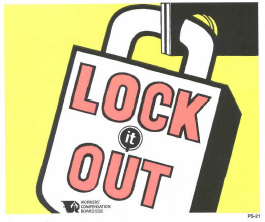Training Room 2
1. Training Room 2
1.6. Page 3
Training Room 2: Workplace Safety in Action
Working with Electricity: Establishing Safe Working Conditions
In Discuss you started to think about what it means to develop a safety plan for working with electricity. When electricity is being used in a work environment, it is important to be aware of the hazards and to be prepared with a plan for safety. This can mean setting up rules and procedures for electrical safety that are communicated to everyone in the workplace.
Location Plan

iStockphoto/Thinkstock
Plans need to be in place at your workplace, school, and home to address electrical hazards. Specific plans need to be made for specific locations. A safety plan for your workplace may look very different than your home safety plan.To make a location plan for electrical safety,
- identify the electrical hazards found at the location
- idenfity practices that reduce risk of injury from those hazards
- make the safety practices easily available in writing to all workers
Personal Plan
You also need a personal plan to make sure that you are working in safe conditions when around electiricty either at home, school, or work. A personal plan is different from a location plan. A personal plan includes the steps you take to ensure your safety, wherever and whenever you are working with electricity.
Your personal plan for electrical safety should include the three keys of electrical safety. Learn about these three keys in “Working Safely Around Electricity.” Jump or scroll to page 44.
Lockout Procedures

Copyright 2006 Workers' Compensation Board of British Columbia
Richmond, B.C., Canada. All rights reserved.
Workers are required to use a lockout procedure when repairing or maintaining electrical equipment. This procedure may also be called a lockout/tagout procedure.
Watch “Lockout for woodworking” to find out why lockout procedures are required and how lockout procedures work. You will use the information in this presentation to develop your list of steps in lockout procedures as part of your Electrical Safety Reference Sheet.
Copyright 2006 Workers' Compensation Board of British Columbia Richmond, B.C., Canada. All rights reserved.
You will find that most provinces require that employers make lockout procedures easily available in writing to workers. Good practice is to post the lockout procedure beside electrical machinery. Find an example of a lockout procedure in the section “De-energization and Lockout” on page 7 of “Working Safely Around Electricity.”
Electrical Safety Reference Sheet
It is time to create your Electrical Safety Reference Sheet, which you will include in your Pocket Guide to Workplace Safety in the Training Room 2 Project.
Your Electrical Safety Reference Sheet must have three items:
- electrical safety plan for your choice of location, organized into two sections: hazards and solutions
- personal plan for establishing safe work conditions, incorporating the three keys of electrical safety
- steps in lockout procedures
You can choose the format of your Electrical Safety Reference Sheet. To decide which format to use, think about how you will use your Pocket Guide to Workplace Safety at work. For example, will you store your Pocket Guide on an iPod or cell phone, or will you carry a print-out to your worksite?
Be sure to include all necessary information and references. Use Training Room 2 Project Rubric to make sure you have met all requirements.
Name your file “Electrical Safety Reference Sheet” and save it in your Pocket Guide to Workplace Safety sub-folder.
Submit a draft of your completed Electrical Safety Reference Sheet to your teacher for feedback. You will submit your final version for marks later in Training Room 2 Project.
Pat yourself on the back! You have completed the electrical safety section. Update your copy of Course Checklist before you move on.
